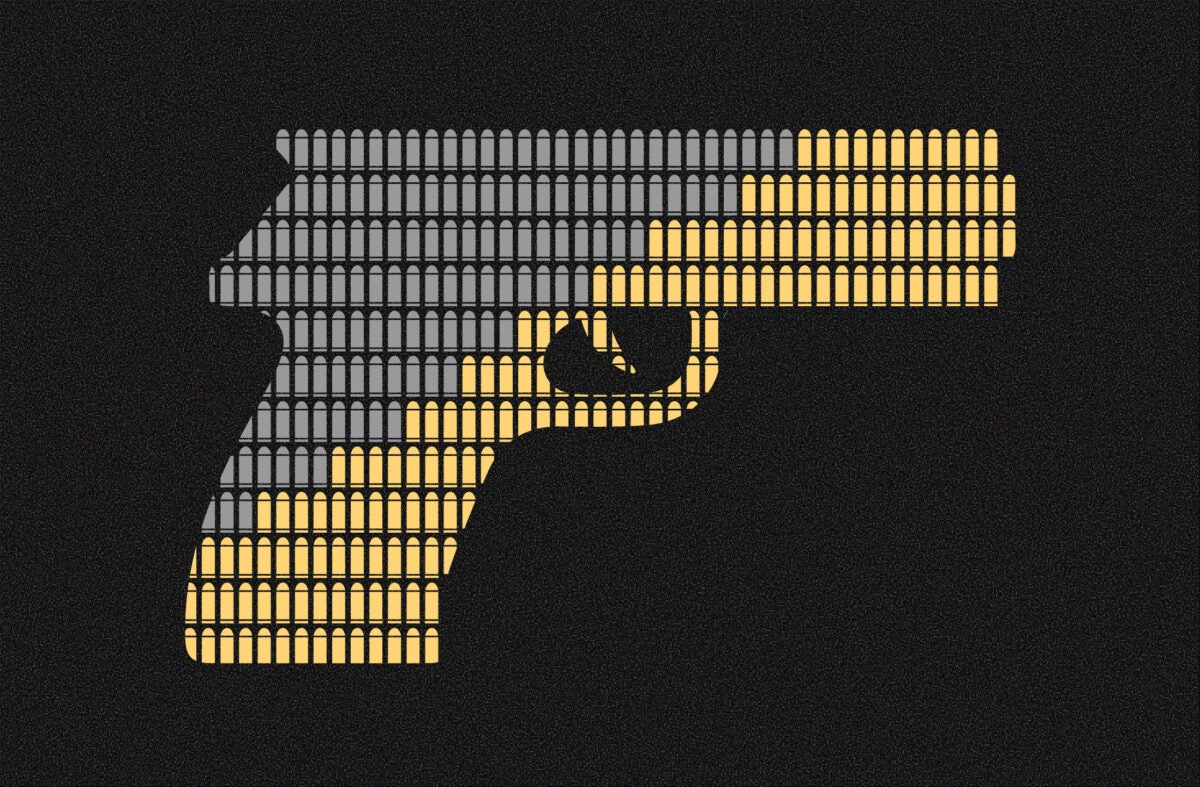
Feature
New gun deaths data in U.S. show continued rise in suicides
The gun control debate always heats up after a mass shooting, as it has in the wake of the twin shootings in California last month. The summer’s mass shootings in Buffalo, New York, and Uvalde, Texas, finally spurred lawmakers to action with the passage of the Bipartisan Safer Communities Act bill, the first meaningful piece of gun legislation in two decades. But the U.S. gun problem is still the world’s worst, and new data shows we have a less well-known, but equally urgent reason to keep talking about gun control: suicides.
Gun homicides, including mass shootings, are a pervasive and horrific issue, and we have rightly focused attention on reducing them. But a majority of gun deaths, 54 percent, in the U.S. aren’t homicides, they’re suicides. Indeed, as the Giffords Law Center to Prevent Gun Violence puts it, suicide is “the untold story of gun violence in America.”
Sign up for Harvard Public Health
Delivered to your inbox weekly.
Both suicides and gun deaths have increased over the last two decades, and there is a strong link between firearms and suicide deaths. Suicide-by-gun makes up most of both gun deaths and overall suicide deaths (over half of each).
85% : mortality rate of suicide attempts involving a gun.
A new study shows firearm suicides have ticked steadily upward since 2004, peaking in 2021. Suicide rates overall have also increased significantly over the past two decades, nearly 30 percent. The American Indian and Alaska Native population, especially, is feeling this pain, with suicide being a leading cause of death in these communities. Suicide rates are highest amongst American Indian tribes, and suicide-by-gun is a growing issue. But it’s white Americans, and white men in particular, who are most likely to pick up a gun to take their own lives.
Access to a firearm is a major risk factor for suicide, as studies like this 2020 New England Journal of Medicine report show. And while it’s difficult to generalize about a whole group, we can say that a lot of white men own guns—about half, compared to roughly a quarter of white women and non-white men, and one in six non-white women. “It is not surprising that the group with the broadest firearm ownership and access sees elevated rates of firearm suicide,” says Kelly Drane, Research Director at the Giffords Law Center to Prevent Gun Violence.
Despite the evidence showing that access to a firearm is a risk factor for suicide, our public discussion is hampered by the myth that anyone who really wants to kill themselves can’t be stopped. But statistics suggest that’s inaccurate.
Eight in ten gun suicide deaths in the U.S. involve white Americans
Nine of ten people who survive their initial suicide attempts ultimately never die of suicide. These numbers imply that most people who attempt suicide can be helped, and ultimately prevented from committing suicide. However, firearms are much deadlier than any other method: 85 percent of people who attempt suicide with a gun die. In fact, though suicide-by-gun only represents five percent of all suicide attempts, it represents about half of all suicide deaths because they are so deadly. “Suicide is often an impulsive act, utilizing whatever means are immediately available,” says Drane. A suicide attempt by other means is likely to remain merely that, an attempt—but a firearm dramatically changes the equation.
Experts say putting “time and space” between a person struggling with suicidal urges and a deadly weapon is crucial, to use an approach favored by suicide researchers. One intervention gaining traction is red flag laws, now on the books in nineteen states and the District of Columbia. These allow police officers—and, in some places, family members and housemates—to petition courts to remove guns from those who may be a threat to themselves or others. “Mostly they get passed in the wake of mass shootings, but research shows they’re actually effective in preventing suicides,” says emergency psychiatrist Amy Barnhorst, vice chair for community mental health at the UC Davis Department of Psychiatry, who helped craft California’s own red flag law, the Extreme Risk Protection Order (ERPO).
That said, comprehensive data on red flag laws don’t exist yet, in part because such laws are relatively new. Before 2018 (when the Parkland, Florida, shooting occurred) just five states had them. But one study of Indiana’s 2006 red flag law found it to be modestly effective: for every ten guns removed from suicidal individuals, at least one life was saved. Other research demonstrates that even mundane gun safety legislation like licensing can help. When Connecticut made gun licenses mandatory, its firearm suicide rate decreased by 33 percent—but when Missouri repealed its licensing law in 2007, firearm suicide deaths shot up 24 percent. “States with the strongest gun safety laws generally have lower rates of gun suicide,” says Drane.
A lack of federal research funding has been a serious hurdle when it comes to creating and evaluating effective interventions for those at risk of suicide. After a 1996 amendment forbade the Centers for Disease Control and Prevention from doing anything that would promote gun control, “federal funding for gun violence research was essentially eliminated,” says Drane. Over the last few years, however, as firearm deaths continued rising, Congress has managed to set aside some money. Since fiscal year 2020, the CDC and National Institutes of Health have received $100 million for gun violence research.
It’s a start—but a paltry one, according to Lois Lee, associate professor of pediatrics and emergency medicine at Harvard Medical School and co-author of a new JAMA study about firearm fatalities. When you consider “the damage suicide does not just to families but the [huge] cost in terms of health care, insurance, lost productivity, and unmeasurable emotional costs to families and communities,” $100 million is “minuscule, a drop in the bucket,” says Lee.
50%: white men who own a gun
Safe storage is another gun safety and suicide prevention measure attracting interest from researchers and policy experts. Rutgers University’s Gun Violence Research Center has created a searchable online map that shows safe gun storage locations like firearm retailers, community businesses, and even police departments for people during a crisis. Emmy Betz, an emergency physician who directs the Firearm Injury Prevention Initiative at the University of Colorado School of Medicine has been leading the charge on how to map safe storage spots. She and her colleagues put together an online toolkit with an overview of existing maps, issues, and how to build a state map. “For suicide prevention, it’s important that gun safety messaging comes from trusted messengers,” says Betz. For many gun owners, those messengers are often firearm retailers.
But different communities trust different kinds of heralds. For example, veterans are more likely to respond to military law enforcement. “People may find a messenger more credible when that messenger seems like an insider,” says Betz.
There’s also been a huge push at the doctor’s office to talk to at-risk patients about guns in the home, says Barnhorst. “These conversations are not illegal—a common misconception.” Moreover, she adds, “patients are supportive of having them.”
That was the recent experience of the JAMA study’s lead author, pediatrician, and researcher Chris Rees. One of his patients was a suicidal adolescent whose father had firearms at home. When Rees pointed out to the father that his son would be safer if he couldn’t get his hands on a gun, the father said, “Oh, I hadn’t thought of that.” He thanked Rees and said he’d look into safe storage. “I think he was sincere,” Rees remarks.
Like Rees is doing, the country needs to pay closer attention—and to put in the money, too.



